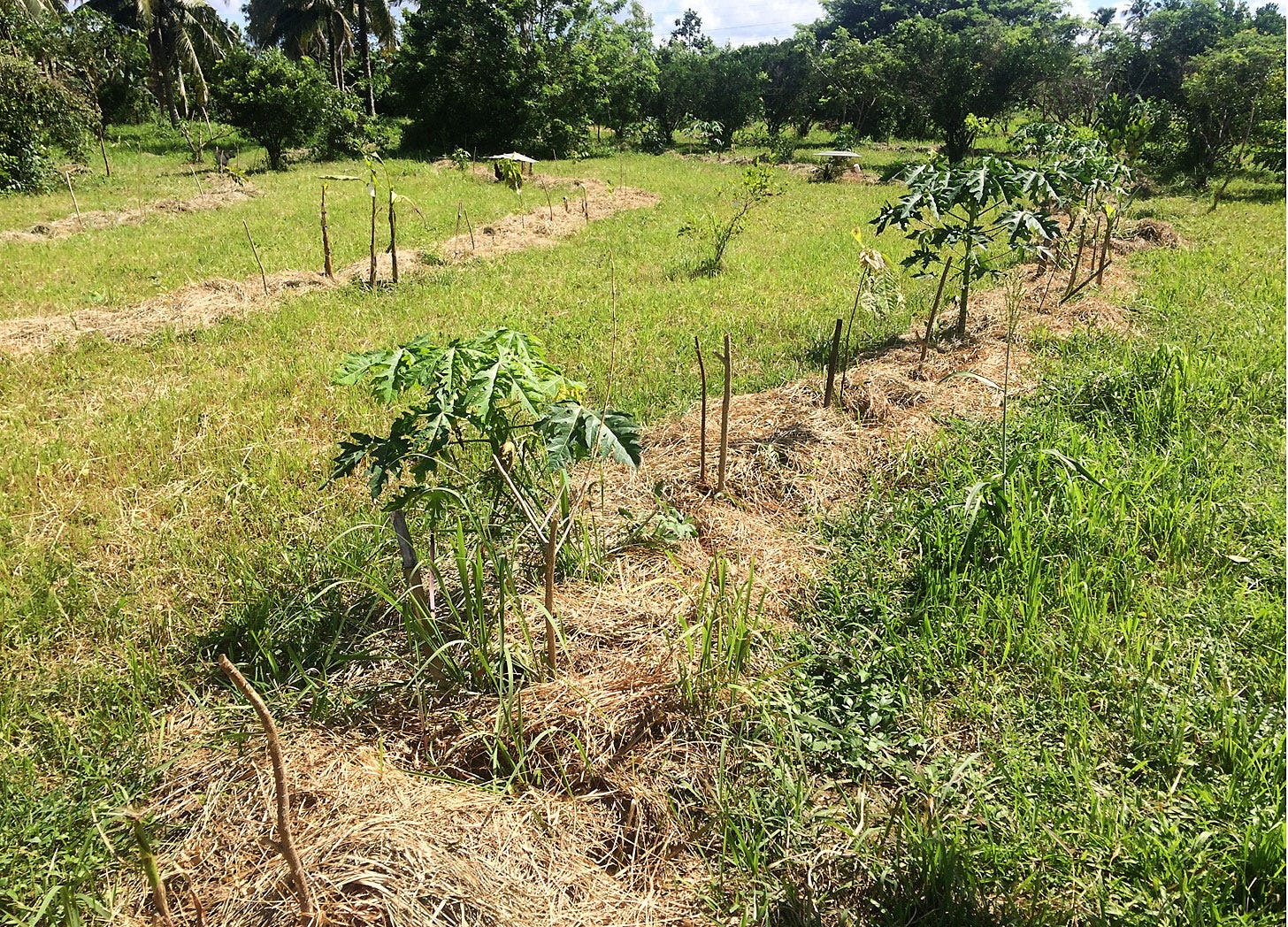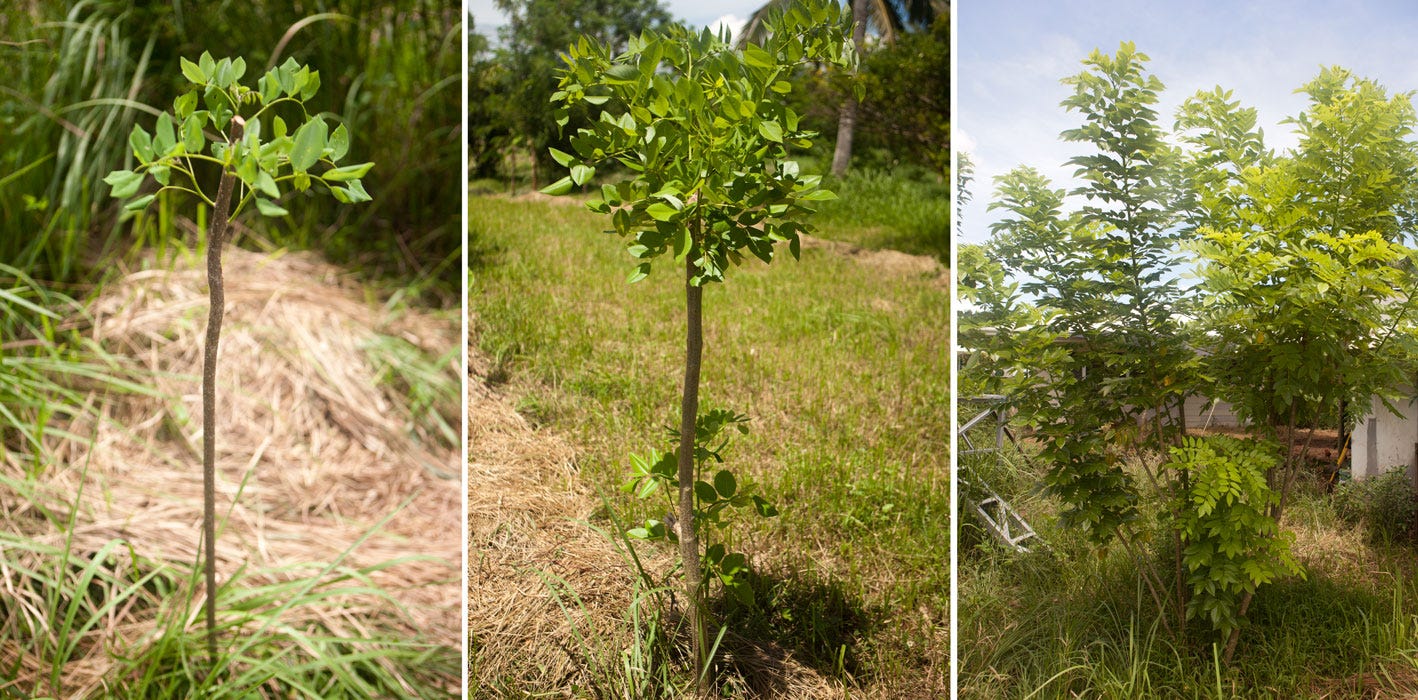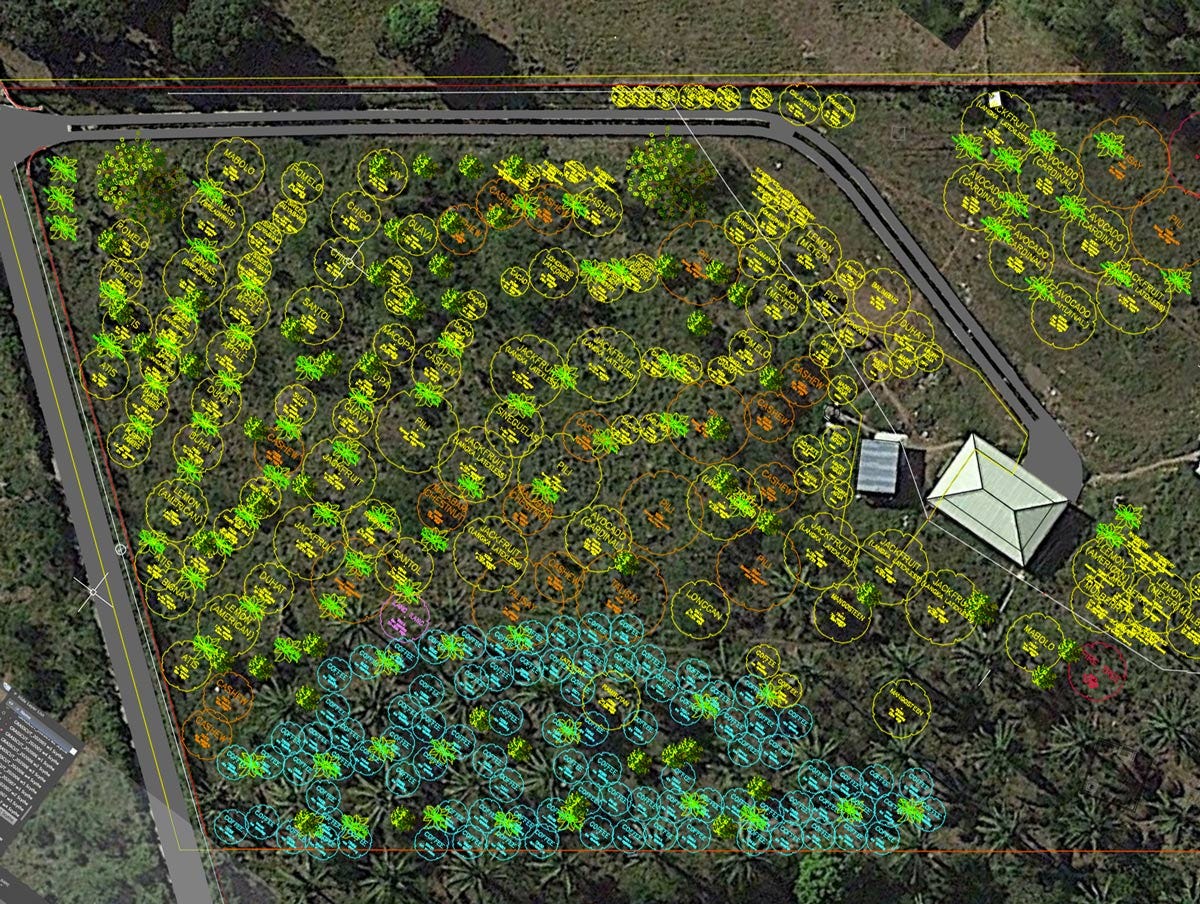Food forest update: First 18 months
This is from quite a while ago and many things have changed and grown, including the way I manage and think about this land that I'm lucky to call my home. From August 2020.
This is what we've been working on at our new farm in Batangas, Philippines. It's a food forest consisting of about 1000+ trees spread over about a hectare. The land was rice fields many years ago but was planted with dalandan (a local citrus good for juicing) and coconuts in the last decade.

I've planted amongst the existing trees along the contours. Mostly because I love me a good topographic map and being able to physically see the "lay" of the land is interesting to me. A variety of different fruits, berries, plenty of nuts (cashews, Indian almond, macadamia and pili), coffee (of course), a few Philippine native flowering trees and some medicinal trees. Hopefully this will go a long way towards being a large part of our diet in the not too distant future (and probably a large part of our time picking and processing it all!)
We get a lot of rain here for half a year and then a long, dry, very hot summer. Last summer I lost a few of the trees (and almost half of my 90 coffee trees) on a particularly brutal week. Watering is just not enough; some need to be shaded from the intense sun. I'm currently planting heavily around all my coffee trees; lots of papaya, madre de cacao (a local nitrogen fixing tree that's often used as a living fence) and Mexican sunflower. Hopefully this will help. I will also slightly bury my irrigation pipes as I can't water after 8am on a summer day; the water out of the tap is too hot.
The way I've built the orchard was heavily influenced by Rancho Mastatal's work (Costa Rica) and more recently by Ernst Gosch's Syntropic agroforestry (Brazil). Lots of mulching to keep the soil protected, which keeps all the soil microbiome happy, who feed the roots of the trees. The mulch comes from the grass between the rows and from chopping and dropping the branches and leaves of the "support" trees within the orchard. In the tropics, the soil is often poor and degraded due to the heavy rain, the key is to retain all your nutrients above the ground; in the plants (biomass).

Since lockdown began in March, I have been scything. It's proven its worth at our farm and is a lot easier than motorised grass cutting. The cut grass is raked into the tree rows and slowly breaks down; feeding the soil microbes and retaining moisture around the new trees. The regular scything improves the soil, increasing its water infiltration rate and cycles nutrients through the system. We’re basically mimicking the (managed) grazing of animals. Grass is one of the most efficient plants at photosynthesis and by regularly cutting it (mimicking managed grazing by animals) it can sequester carbon in the soil. At this time of year, rainy season, I can cut once a month. My last cut will have to be timed just before the start of dry season; so that there is sufficient grass to keep the soil covered during the summer.
I'm a total newbie to mowing with a scythe but it's so much more enjoyable and easier on the body than using a whipper/sniper. This time of year the grass grows quickly, I mow for 1.5 to 2 hours at dawn every day and by the time I've finished most of the property it's time to start again.
The video below show Guinea grass. It's a highly efficient plant at fixing atmospheric CO2 from photosynthesis. It's scratches the f**k out of you also. I tried planting nut trees in this area, which is close to the river's cliff edge, but a hard bedrock sits about 20cm below the surface. I'm now planting mulberries and more madre de cacao which will be used for future goat forage.
We also add a lot of the cut grass to our chicken run. Food scraps and grains are thrown onto the grass and the chickens' constant scratching, digging and pooping slowly break it down into a nitrogen-rich mulch that we apply heavily to our veggie garden beds. I've also tried making compost with the cut grass but the time and energy I spend building and turning the piles doesn't seem worth the lackluster results I get from it (not enough leaf/carbon in the piles).
I've completed planting the main fruit, nut and medicinal trees. The task now is to fill up the spaces between the trees with all sorts of nitrogen fixing plants, eucalyptus trees for timber, faster growing edibles such as papaya, pineapples, cassava, peanuts, sweet potato, ginger, turmeric. Basically anything I can get my hands on or anything I can propagate from our existing trees. It is crowded, but as the system grows, a lot of the support plants will be cut down and mulched, making room for the main trees to reach their full size. I would love to have it perform as well as a Syntropic system but I think my row spacings may be a bit wide. As the amount of biomass in the system increases I may introduce new rows of trees between the existing ones, depending on time and budget. I also plan to plant corn, sorghum, native millet, Adlai and other cereals between the rows using no-till methods so that the soil-food web is not disturbed.

The trees were planted without fertiliser so growth in the first year was pretty slow. In a month or so I will fertilise everything with humanure. Yes, I've been shitting in a bucket for the last year. On a permaculture farm there is no such thing as "waste". This is returning nutrients that would otherwise be lost, back into the system.
Future plans include:
Planting Philippine native trees and bamboo along our cliff and "jungle" areas; these are places we rarely venture, will be left wild in a mostly untouched state and are home to most of our wildlife; bats, wild bees, monkeys, birds.
Running a chicken tractor through the grassed areas for extra fertilisation. I did this last year but the chicken shelter was a bit heavy and I could only muster the energy to move it every ten days or so. Hopefully I can make something much lighter out of our giant bamboo we have growing near the river. I currently have three caged roosters, that I'm rather fond of and not needing to cull, moved twice a day along the rows.
A milking goat to rotationally graze around the property. I want to wait till after summer to ensure I have enough forage to feed it an entire year without resorting to feeds. A local farmer here lost 1000 goats during lockdown because his helpers weren't allowed to go out looking for grass! Hopefully we can mate her with the neighbour's buck each for a continuous supply of milk and the occasional goat meat.
Microbial teas for inoculating the soil. I've already started with fish hydrolysate; a soup full of fermented fish which I'll feed with local molasses and spray early morning on the new trees and into the mulch to encourage the soil microbes to proliferate.

Regenerative agricultural systems such as these are ideal for idle, unused land across the Philippines in order to sequester as much carbon out of the atmosphere as we can. It can provide a yearly income to farmers through vegetable and grain production while building a longer term investment of food trees for future food security. These systems are also great ways of speeding up nature's succession process of rewilding land and restoring tropical forests.
In many western countries, landowners are already being paid for their carbon sequestration efforts. Many European countries are hungry to offset their carbon footprints in foreign countries and it would be a great opportunity if the Philippines could seize this moment to get foreign investments. An example of this was a scheme in Nepal ... So any wealthy hedge fund managers (hint hint) that have money burning holes in their pockets at the moment, any donations to help us out with trees and tools (not living expenses) would be more than greatly appreciated!!
For anyone with further interest, here's resources that I found greatly useful over the past few years of planning and planting the tropical orchard:
Kiss The Ground: we did the soil advocacy course when it was first offered for free and it was quite mind blowing and has since dictated the way we look after our soil. Restoring soil is one of the best chances we have of reducing atmospheric CO2 and needs to be put into agricultural policies all over the world. They have a film coming out in September which will hopefully make huge waves all over the world.
Ernst Gosch's "Life in Syntropy" video
Forest gardens in Nepal: an successful scheme used in Nepal to establish food forests with small land holders, funded by the international carbon market.
Project Drawdown: solutions to reducing heat trapping gases. Just take a look at how many are agricultural/forestry solutions.


